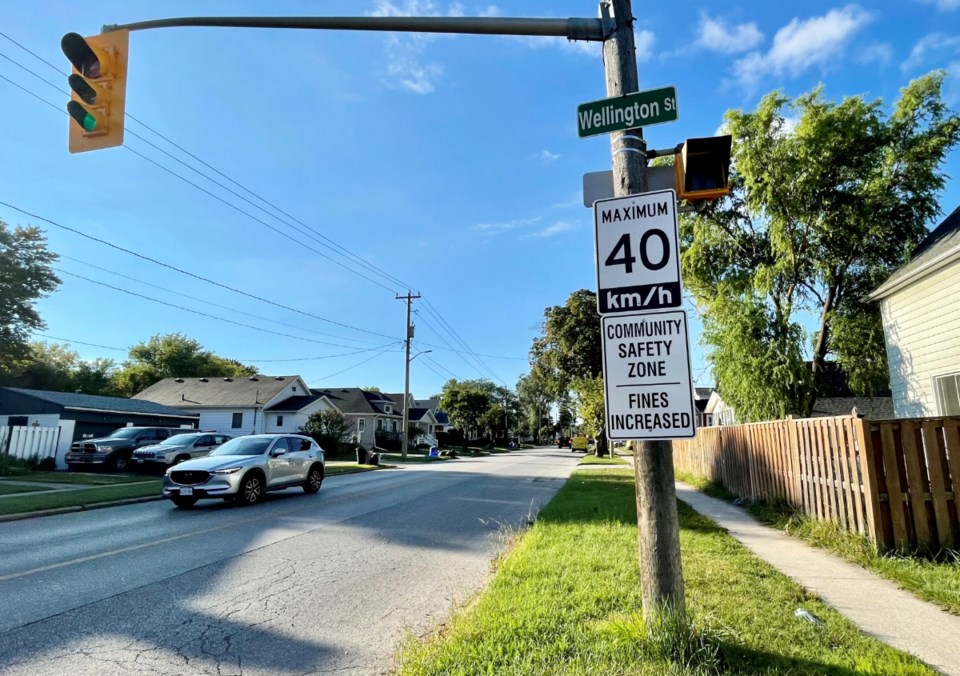Tara Jeffrey
When Pamela Simmons moved to Sarnia last year, she was struck by what she saw on the roadways.
“One of the first things I noticed was, ‘Wow, these people go fast,’” she said. “It’s like a speedway here — and it’s a school zone.
“Like, where are these people going?”
Simmons is one of a number of residents voicing concern about speeding drivers. And last week city council agreed to seek public input on a possible citywide reduction of speed limits.
“I certainly know that the popularity of the ‘slow down’ signs indicates there are a lot of people out there that have issues with speeds through neighbourhoods,” said councillor Brian White, referring to 170-plus lawn signs requested through a campaign Sarnia launched last year.
“And I’ve certainly heard from people concerned about speeds… even in neighbourhoods that don’t have schools in them.”
Council directed staff to conduct public engagement on a citywide speed limit reduction.
Staff will also explore opportunities and report back on a pilot project for Automated Speed Enforcement, better known as photo radar.
Councillors Terry Burrell, George Vandenberg, and Mike Stark voted against the idea.
“I think we are going in the wrong direction on this,” Burrell told council. “I have not seen this come from the people at all…I think we should just acknowledge what’s in the system at this point and set it aside.”
A staff report listed various options. They include:
* Dropping the speed limit to 40km/hr on all local and collector roads, leaving arterial road at their posted speed;
* Dropping the speed limit to 40km/hr in all special concern areas, like school zones, community parks, hospitals and nursing homes;
* Dropping the speed limit to 40km/hr in designated neighbourhood areas within the city (say, all of Heritage Park, for example).
“No Ontario municipality has moved forward with implementing a city-wide reduction to date,” said Alister Brown, the city’s manager of development and transportation.
“Some have lowered the speed limit in widespread areas while others, including Sarnia, have implemented reduction in specific zones.”
Last year, Sarnia approved Community Safety Zones around four elementary schools, a first step toward installing photo radar to nab speeders.
At the time, the pilot project was coupled with the intention that ASE would be reviewed when more data was available from other municipalities, the city said.
“Staff has had positive feedback from the community as well as requests for additional locations,” the report noted, adding that one of the zones — at P.E. McGibbon School on Russell Street — has had little impact on overall driver behaviour.
“This suggests that the signage alone will not slow vehicles down but would be more effective with the addition of other traffic calming measures and increased enforcement,” the report states.
Simmons said she favours slower speeds and signage around all school neighbourhoods, rather than a citywide reduction.
“There’s kids everywhere, and nothing is posted. It’s a school zone — that should be a thing,” she said.
“Then what happens is, too many people treat a 50km/hr zone like a 60km/hr zone, or more.”
One advantage to implementing broader, community-wide speed reduction is that drivers “would be aware they should always be driving slower, rather than being comfortable and used to driving a higher speed and then coming across short sections of lower speed limits which the then ignore,” the staff report noted.
Statistics show lowering speeds by 10-to- 12km/hr has a significant impact on the survival rate of pedestrians involved in road collisions, it notes.
“I don’t know what the solution is,” said Simmons.
“The whole city slowing down? Yes, but certain areas, like school zones, need to be addressed.”
